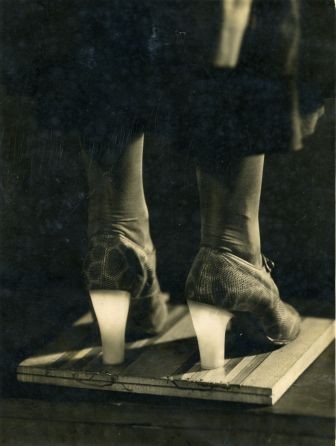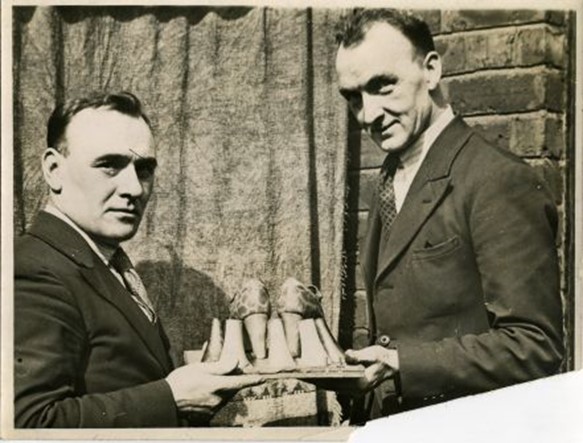
This photograph is one of my favourite things in the collection. I even have a copy of it next to my desk. The story of these shoes shows the entrepreneurial spirit of Manchester. It’s also a tale of innovation, perseverance and imagination, but ultimately disappointment. I love the image because the idea of a woman patiently standing on a wooden board on top of a wall, wearing dancing shoes with heels that light up, in a pair of slightly wrinkled stockings makes me laugh.
The story starts with Joseph and John Jordan, brothers who owned a boot and shoe repair shop in Oldham. During the early 1930s, they wanted to take advantage of the versatility of celluloid and create jobs for unemployed men in Manchester. When people hear the word ‘celluloid’ they typically think of the physical film used in the movie business, but it’s a type of plastic that used to be used for a multitude of products because it’s easy to mould and shape.
However, one of its major disadvantages was its flammability, which is why today it’s only really used for table tennis balls and guitar picks.

In 1934, Joseph and John developed a non-flammable celluloid shoe heel that didn’t get damaged by hard flooring. In a stroke of imagination, they made a hollow inside the heel, which was large enough to hold a miniature battery and a light bulb. As the wearer of the shoe brought the heel to the ground, the pressure created a contact so that the bulb lit up.
The brothers patented the idea and got a lot of interest from other British manufacturers who saw the invention as ahead of its time. However, the heels never went into production. One reason was the brothers’ desire to keep manufacturing local, so despite plenty of offers from other places the brothers refused to make them anywhere but Manchester. Despite the obvious novelty factor, they were turned down again and again by potential buyers.
Finally, famous theatre impresario and pantomime director Julian Wylie took a shine to the idea for his 1935 production of Puss In Boots at Manchester’s Palace Theatre. He commissioned a set of shoes for the entire chorus line. They would wear heels in different colours, and the stage was to be plunged into darkness as they danced, showing off the heels to magical effect. But, in another stroke of bad luck, Wylie died before the shoes could be put into production, and the idea never saw the light of day (or the dark of the theatre stage).
Joseph Jordan went on to develop other ideas, such as electrical equipment to ensure safe landing of aircraft in darkness, fog and mist, and anti-dazzle glasses for car drivers but none of his inventions went into production. He and John continued to run their shop until 1963.
It wasn’t until the light up soles of LA Gear trainers hit the streets in 1992 that illuminated shoes became a thing. Now they’re everywhere, from kids’ trainers and DIY creations to $2,500 Jimmy Choos. I wonder what the Jordan brothers would think of that!